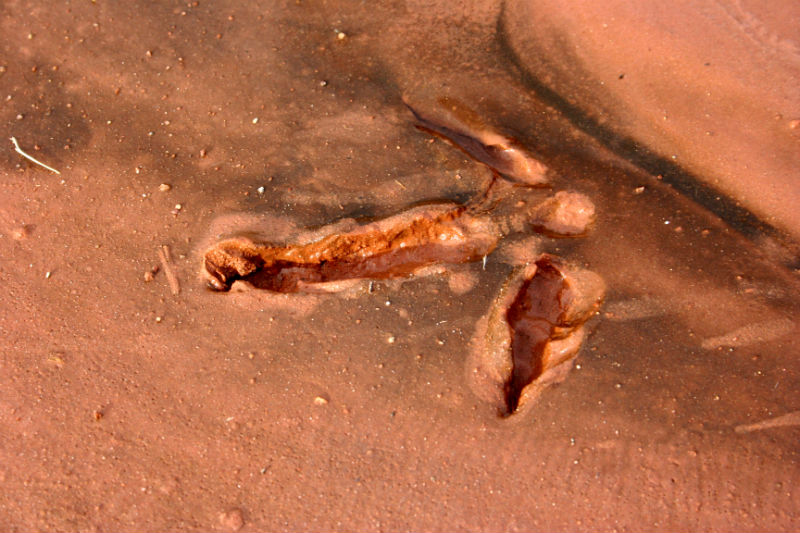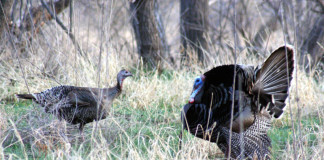Tracking has become a lost art, but it’s a skill that makes a huge difference no matter quarry you’re hunting. For generations, learning the signs left by critters meant the difference between finding something for the dinner table or relying on leftovers – or simply not eating.
In this day and age of the high-resolution game camera and apps and smartphones, numerous devices have made hunting pursuits easy, or at least easier to a large degree.
However, if you’re looking to get back to the basics, spring turkey hunting is the pursuit for you. Improved technology in the form of more realistic decoys and calls and advances in shotguns and camouflage certainly have helped to even the playing field, but a gobbler is near the top of the list – if not in the top spot – in terms of hampering hunter success.
Texas hunters typically have tagged a bird on roughly 30% to 40% of their hunts since state biologists began tracking spring turkey data 30 years ago. That’s far from the 80 percent to 90 percent figure that comes with white-tailed deer harvest in notable Texas hunting hot spots such as the Hill Country during the fall.
Spring turkey hunters can rely on natural signs, which are both visual and audible, to increase their chances of putting themselves closer to a gobbler. The spring is mating season, which means that if you also locate hens, a tom or multiple toms won’t be far behind.
Among the most notable of ways to locate a gobbler is to find a roost, which typically is in large trees – even dead ones – and in drought conditions the lack of foliage also can play into your success of finding these sites. Some areas of the state still look like forests, while others may have a single lone cottonwood or old oak adjacent to open fields. In the latter instances, that’s the first place to look.
While visual inspection will yield if turkeys are on or near a roost, it’s also possible to get audible results, using a locator call such as those mimicking an owl or crow during evening or early morning hours when gobblers are prone to alerting hens of their presence. If you locate birds during an evening, you should plan to set up nearby in the morning in hopes of intercepting them when they fly down. It should be noted that it’s illegal to hunt roosting turkeys, so don’t try and shoot them right off their perches, which also is sure to be before or after legal shooting hours.
While it may seem an easy approach, it’s no guarantee that you’ll fill a tag if you set up near where the birds have holed up. In fact, it’s more likely you won’t, but that doesn’t mean you should hang up your gear for the day. I’ve been on as many late morning and afternoon outings that ended with success as those that included a quick hunt right after sunrise.
This is the real pursuit of turkey hunting, which involves putting in more time tracking to find areas where hens travel and where gobblers like to hang out and strut.
The easiest way to find strutting areas and travel corridors is to look for sign that includes feathers, tracks and scratches. Strutting toms often will push their wing tips down onto the ground, which can leave distinct lines. Turkey tracks are easy to decipher, with three-toed impressions that stand out even in the finest of sediment. Hens and gobblers each have three toes, but the middle toe of a mature gobbler is longer than those on the sides. If the toes all look similar the track likely is that of a hen.
Scratching is what describes the sign left by turkeys in their pursuit of food, with obvious areas rooted up in a less invasive way but similar to that of feral hogs. Turkeys will scratch through sand, dirt, leaves and other vegetation to find insects and anything else that’s on the menu, which means that if you locate large tracts that have been altered you are closer to birds than you may think.
Another turkey sign you can learn to decipher is that left by dusting. Turkeys will attempt to keep their feathers and skin free of anything that can bite back by roiling up dirt, which can make a slight bowl in the terrain. These areas are distinctive if you know what to search for, especially if multiple birds are congregated together.
All signs point to a good rest of the spring turkey framework, with many hunters already tagging at least one bird. With a little luck – and a good dose of work – you too will enjoy a successful outing.
And as I’ve noted before, even successful trips don’t always end with a bird in the bag.
Texas Spring Turkey Hunting: Parting Shots
Here are five quick things that could increase your chances of harvesting a mature gobbler this month and into May across the Lone Star State.
Patience: This is key especially since many hunters pack it in between periods of peak gobbling activity thinking birds have become call-shy. Gobbling peaks right before breeding season (early) and again after hens are on nests (late).
Timing: Hunt as much as possible later in the season when hens are sitting on nests and gobblers are roaming around looking for attention. It’s tough to break a mature bird away from a harem of hens.
Talking: There is a variety of vivid calls on the market and each is suited to fooling a wily critter with a brain the size of a walnut. It should be noted that electronic calls are legal during the spring season, though I’ve seen turkeys still not fall for that ruse on occasion. And yes, there is an iPhone app that features 21 calls, which actually is a good template with which to practice your technique.
Decoys: It’s all about being seen, and once you catch an amorous gobbler’s attention with any number of lifelike models, you’ve got a much better chance of calling it in.
Other lures: In the early season, sometimes you’ve got to hunt near food sources or supplemental feeders if birds aren’t responding. Calling birds into shotgun range is the ultimate attraction of spring hunting, however, many a turkey has been taken with small-caliber rifles during April-May dates.
Texas spring turkey hunting seasons
The spring Rio Grande turkey framework in “northern” counties runs from March 29 to May 11, 2025, while the season in southern counties is from March 15 to April 27, 2025. The north zone youth-only season is March 22-23 and May 17-18, 2025. The youth-only dates in the south zone are March 8-9 and May 3-4, 2025.
There also is a one-turkey bag limit season than runs April 1-30, 2025, in the following counties: Bastrop, Caldwell, Colorado, Fayette, Jackson, Lavaca, Lee, Matagorda, Milam and Wharton. Birds killed in those counties must be reported to TPWD under mandatory requirements.
The Eastern turkey season in East Texas will run April 22 to May 14, 2025. Hunters are required to report harvest of eastern turkeys electronically to TPWD within 24 hours of harvest. Reports in mandatory counties can be made through the TPWD My Texas Hunt Harvest App or online from the TPWD website.
In addition to a Texas hunting license, an upland game bird endorsement is required to hunt turkeys.
Turkey hunting in Texas brings need to know tips, tactics, regulations
Texas spring hunting pursuits bring out critters that bite back



















